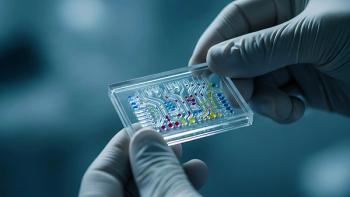
- BioPharm International-08-01-2012
- Volume 25
- Issue 8
Performing Hydrogen/Deuterium Exchange with Mass Spectrometry
In HDX studies, data are produced across multiple time points, multiple species, and with replicates.
Invention, adaptation, and innovation have played a role in developing commercial hydrogen/deterium (H/D) exchange (HDX) systems. HDX as a technique was pioneered by Lindstrom Lang in the 1940s. The basic principle is straightforward: place a molecule in a solution of D2O and measure how many—and how quickly—hydrogen atoms exchange with deuterium atoms. From this measure, the higher order structure of the molecule, typically a protein, could be inferred.
Some regions of a protein would have faster uptake than others, and regions can be compared to provide a detailed picture of the three-dimensional structure of the protein. This allows proteins in different states or with mutations to be compared and correlated to biological activity. Lang used crude techniques, such as scintillation meters, to time the different rates at which deuterated versus nondeuterated samples fell through a liquid-filled tube under the action of gravity. The biotechnology industry has since adopted this method as a routine technique (1, 2).
Figure 1 (HDX/MS): A depiction of the relative deuterium uptake for interferon helps one visualize and interpret the higher order protein structure related to conformational change. The uptake measurements are made at the peptide level for multiple time points across the experiment. Each uptake measurement is superimposed on the 3D structure of the protein, typically obtained from an X-ray representation.
Although HDX had previously been performed with high-performance liquid chromatography (HPLC), HPLC had weaker separation power. For HDX with mass spectrometry (MS), ultra-performance liquid chromatography (UPLC) separations allow more detailed measurements, an important consideration for use with proteins as large as antibodies. UPLC, therefore, improved the efficiency of HDX by having a higher degree of separation concomitant with robustness One challenge in quantifying deuterium uptake was the dynamic nature of the process. Deuteration is not a one-way street: molecules in solution will exchange back and forth dynamically, so in order to measure the process accurately, the exchange had to be chemically quenched to a pH of 2.5 (for proteins) and the analytical separation simultaneously cooled to 0 °C to manage the "back" exchange. Operating at such cold temperatures was not the sort of treatment chromatographic systems were originally designed for, so innovation was needed was to make a refrigerator unit integrated with the UPLC system. Having a cold pathway manages the reversal of the deuteration and brings the chromatographic separation as close to the detector as possible (3).
Another element in advancing HDX with UPLC/MS was the availability of a detection system that could cope with the complexity of the analysis and be able to make reproducible, quantitative measurements. The detection technique most appropriate for this need was an existing methodology applied in a new way: mass spectrometry with MSE (Waters Corp.). In MSE methodology, peptides are detected intact and then fragmented in rapid succession in the collision cell of the mass spectrometer, dozens of time per second (1). This method is possible in QTof and SYNAPT spectrometers, which are hybrid, tandem mass spectrometers (Waters Corp.) Therefore, for the same (peptide) ion, an accurate mass and an amino acid sequence is available. From the differences in masses between deuterated and undeuterated peptides, a precise determination of uptake, as well as proof of assignment, can simultaneously be made. This gain in information content allows the precise location of conformational changes (1, 4, 5).
As more complex proteins are analyzed, it also becomes increasingly useful to include ion-mobility separations to disentangle the data (6, 2). Ion mobility separations are built in to SYNAPT mass spectrometers and have helped to further advance the HDX/MS applications area (7).
In HDX studies, data are produced across multiple time points, multiple species, and with replicates. Curating this data manually is not time-efficient and requires expert interpretation. The interpretation is a repetitive process that requires counting and measuring spectra, so the process can be automated with some in-built intelligence. Software (DynamX, Waters Corp.) is designed to systematically select spectra with predetermined criteria and measure the mass change of the deuterated form. The software automation was greatly simplified by having sharper peaks and better separation with UPLC, and the comprehensive nature of the MSE detection. This automation, along with the capability to sort and display data, has been an important advance.
St. John Skilton, PhD, is senior manager, business operations, LSD, pharmaceutical life sciences, Waters Corp.
REFERENCES
1. I.A. Kaltashov et al., J. Am. Soc. Mass. Spectrom. 21 (3), 323–337 (2010).
2. R.E. Iacob, J.P. Murphy, and J.R. Engen, Rapid Commun. Mass Spectrom. 22 (18), 2898–2904 (2008).
3. T.E. Wales, Anal. Chem. 80 (17), 6815–6820 (2008).
4. J. Engen, Anal. Chem. 81 (19), 7870–7875 (2009).
5. Z. Jianming et al., Nature 463 (7280), 501–506 (2010)
6. K.D. Rand et al., "Gas-Phase Hydrogen/Deuterium Exchange in a Traveling Wave Ion Guide for the Examination of Protein Confirmations, Anal. Chem.online, DOI 10.1021ac901897x, Nov. 18, 2009.
7. R.E. Iacob et al., Proc. Natl. Acad. Sci. 106 (5), 1386–1391 (2009).
Articles in this issue
over 13 years ago
BioPharm International, August 2012 Issue (PDF)over 13 years ago
Pre-use Filter-Integrity Testing: To Test or not to Test?over 13 years ago
Streamlining Batch Record Review and Approvalover 13 years ago
Report from Japanover 13 years ago
Compressing Drug Development Timelines with Accelerated Immunoassayover 13 years ago
FDA User-Fee Legislationover 13 years ago
A 25-Year Retrospective on Orphan Drugsover 13 years ago
Discovery Pipeline: Topical Delivery of siRNAover 13 years ago
Gauging Biopharm OutsourcingNewsletter
Stay at the forefront of biopharmaceutical innovation—subscribe to BioPharm International for expert insights on drug development, manufacturing, compliance, and more.




